Strategies for reducing air pollution Research 2022
VerifiedAdded on 2022/09/22
|14
|3269
|22
AI Summary
Contribute Materials
Your contribution can guide someone’s learning journey. Share your
documents today.

Strategies for reducing air pollution from emission of private vehicles in Melbourne
Secure Best Marks with AI Grader
Need help grading? Try our AI Grader for instant feedback on your assignments.
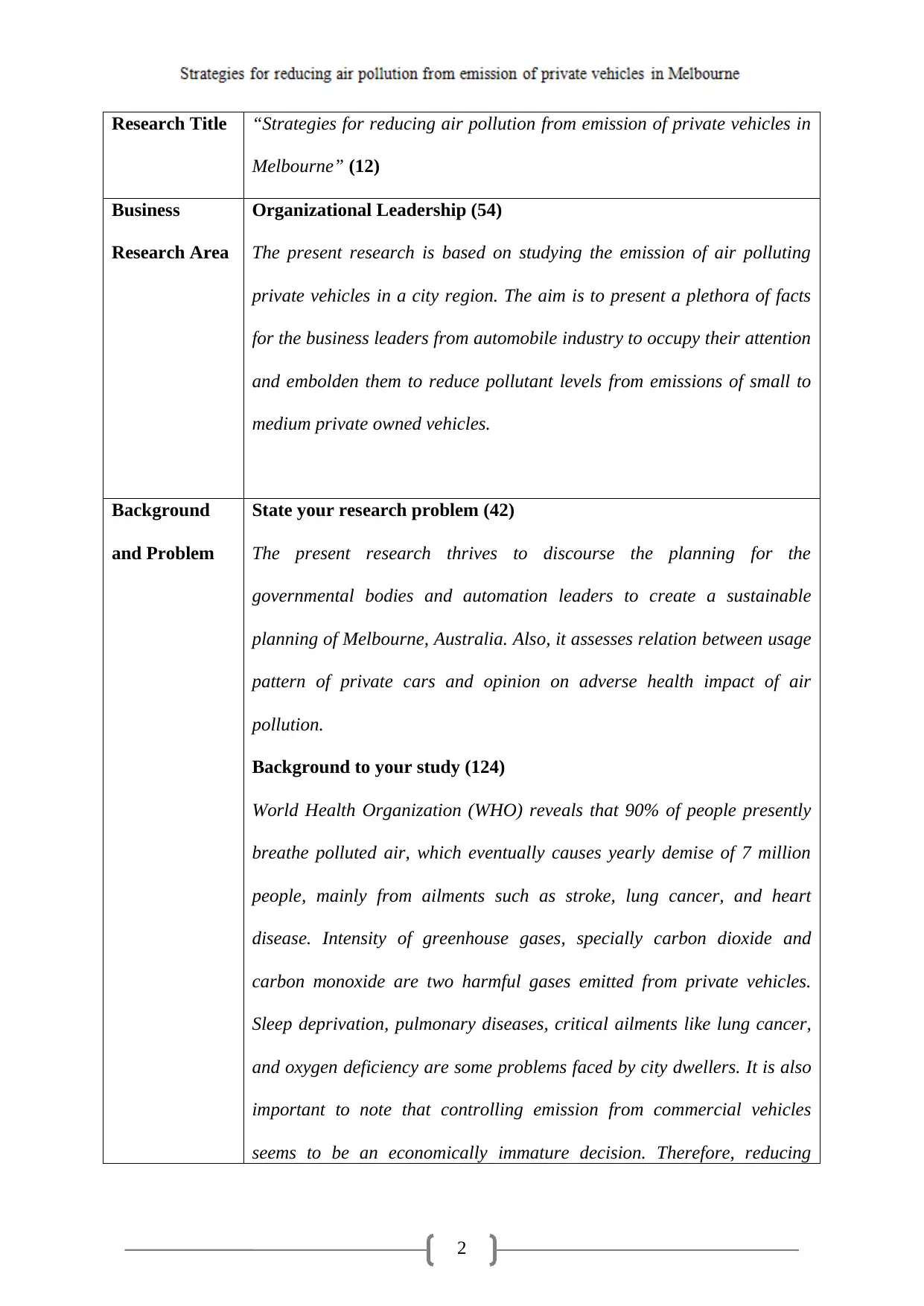
2
Research Title “Strategies for reducing air pollution from emission of private vehicles in
Melbourne” (12)
Business
Research Area
Organizational Leadership (54)
The present research is based on studying the emission of air polluting
private vehicles in a city region. The aim is to present a plethora of facts
for the business leaders from automobile industry to occupy their attention
and embolden them to reduce pollutant levels from emissions of small to
medium private owned vehicles.
Background
and Problem
State your research problem (42)
The present research thrives to discourse the planning for the
governmental bodies and automation leaders to create a sustainable
planning of Melbourne, Australia. Also, it assesses relation between usage
pattern of private cars and opinion on adverse health impact of air
pollution.
Background to your study (124)
World Health Organization (WHO) reveals that 90% of people presently
breathe polluted air, which eventually causes yearly demise of 7 million
people, mainly from ailments such as stroke, lung cancer, and heart
disease. Intensity of greenhouse gases, specially carbon dioxide and
carbon monoxide are two harmful gases emitted from private vehicles.
Sleep deprivation, pulmonary diseases, critical ailments like lung cancer,
and oxygen deficiency are some problems faced by city dwellers. It is also
important to note that controlling emission from commercial vehicles
seems to be an economically immature decision. Therefore, reducing
Research Title “Strategies for reducing air pollution from emission of private vehicles in
Melbourne” (12)
Business
Research Area
Organizational Leadership (54)
The present research is based on studying the emission of air polluting
private vehicles in a city region. The aim is to present a plethora of facts
for the business leaders from automobile industry to occupy their attention
and embolden them to reduce pollutant levels from emissions of small to
medium private owned vehicles.
Background
and Problem
State your research problem (42)
The present research thrives to discourse the planning for the
governmental bodies and automation leaders to create a sustainable
planning of Melbourne, Australia. Also, it assesses relation between usage
pattern of private cars and opinion on adverse health impact of air
pollution.
Background to your study (124)
World Health Organization (WHO) reveals that 90% of people presently
breathe polluted air, which eventually causes yearly demise of 7 million
people, mainly from ailments such as stroke, lung cancer, and heart
disease. Intensity of greenhouse gases, specially carbon dioxide and
carbon monoxide are two harmful gases emitted from private vehicles.
Sleep deprivation, pulmonary diseases, critical ailments like lung cancer,
and oxygen deficiency are some problems faced by city dwellers. It is also
important to note that controlling emission from commercial vehicles
seems to be an economically immature decision. Therefore, reducing
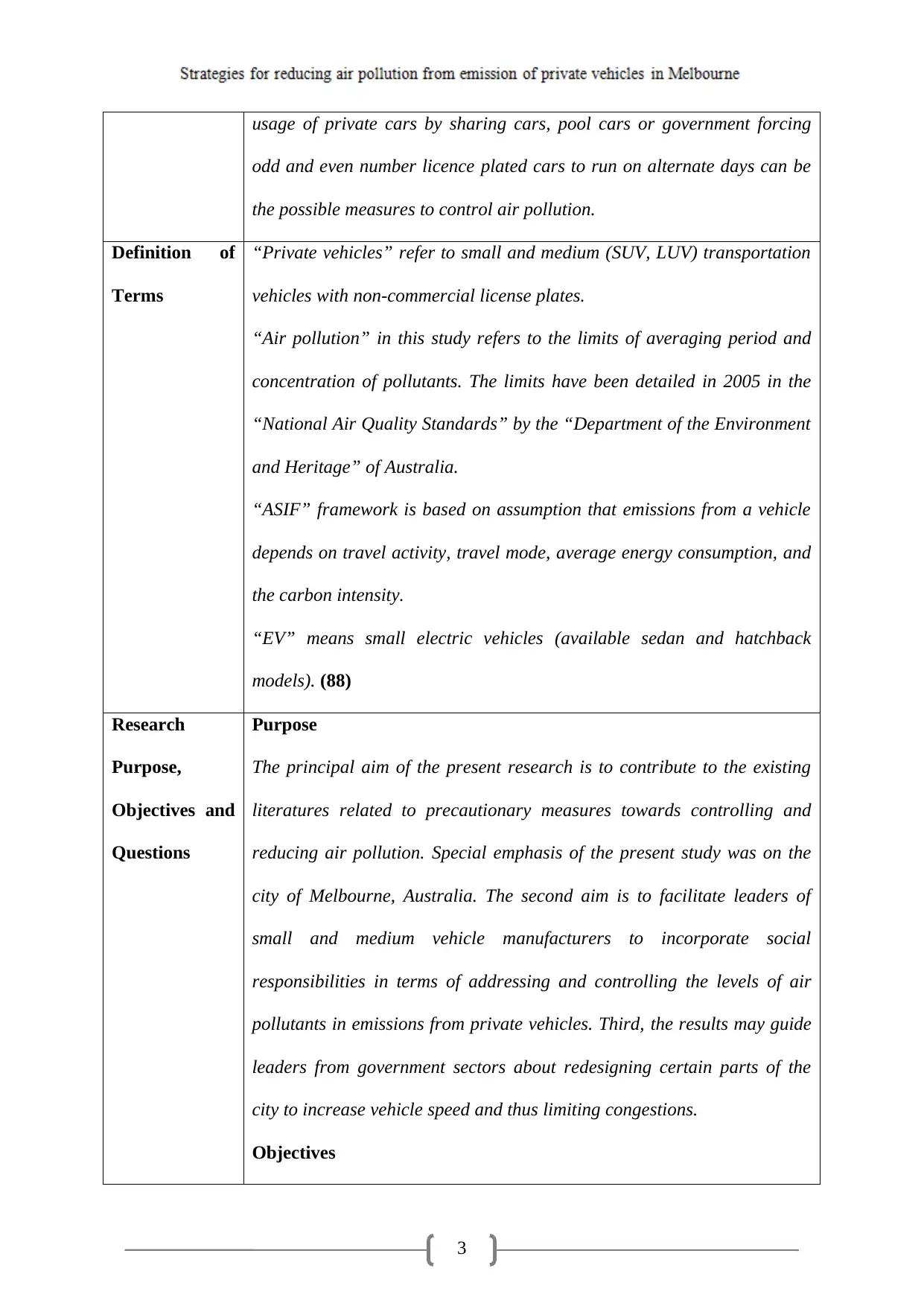
3
usage of private cars by sharing cars, pool cars or government forcing
odd and even number licence plated cars to run on alternate days can be
the possible measures to control air pollution.
Definition of
Terms
“Private vehicles” refer to small and medium (SUV, LUV) transportation
vehicles with non-commercial license plates.
“Air pollution” in this study refers to the limits of averaging period and
concentration of pollutants. The limits have been detailed in 2005 in the
“National Air Quality Standards” by the “Department of the Environment
and Heritage” of Australia.
“ASIF” framework is based on assumption that emissions from a vehicle
depends on travel activity, travel mode, average energy consumption, and
the carbon intensity.
“EV” means small electric vehicles (available sedan and hatchback
models). (88)
Research
Purpose,
Objectives and
Questions
Purpose
The principal aim of the present research is to contribute to the existing
literatures related to precautionary measures towards controlling and
reducing air pollution. Special emphasis of the present study was on the
city of Melbourne, Australia. The second aim is to facilitate leaders of
small and medium vehicle manufacturers to incorporate social
responsibilities in terms of addressing and controlling the levels of air
pollutants in emissions from private vehicles. Third, the results may guide
leaders from government sectors about redesigning certain parts of the
city to increase vehicle speed and thus limiting congestions.
Objectives
usage of private cars by sharing cars, pool cars or government forcing
odd and even number licence plated cars to run on alternate days can be
the possible measures to control air pollution.
Definition of
Terms
“Private vehicles” refer to small and medium (SUV, LUV) transportation
vehicles with non-commercial license plates.
“Air pollution” in this study refers to the limits of averaging period and
concentration of pollutants. The limits have been detailed in 2005 in the
“National Air Quality Standards” by the “Department of the Environment
and Heritage” of Australia.
“ASIF” framework is based on assumption that emissions from a vehicle
depends on travel activity, travel mode, average energy consumption, and
the carbon intensity.
“EV” means small electric vehicles (available sedan and hatchback
models). (88)
Research
Purpose,
Objectives and
Questions
Purpose
The principal aim of the present research is to contribute to the existing
literatures related to precautionary measures towards controlling and
reducing air pollution. Special emphasis of the present study was on the
city of Melbourne, Australia. The second aim is to facilitate leaders of
small and medium vehicle manufacturers to incorporate social
responsibilities in terms of addressing and controlling the levels of air
pollutants in emissions from private vehicles. Third, the results may guide
leaders from government sectors about redesigning certain parts of the
city to increase vehicle speed and thus limiting congestions.
Objectives
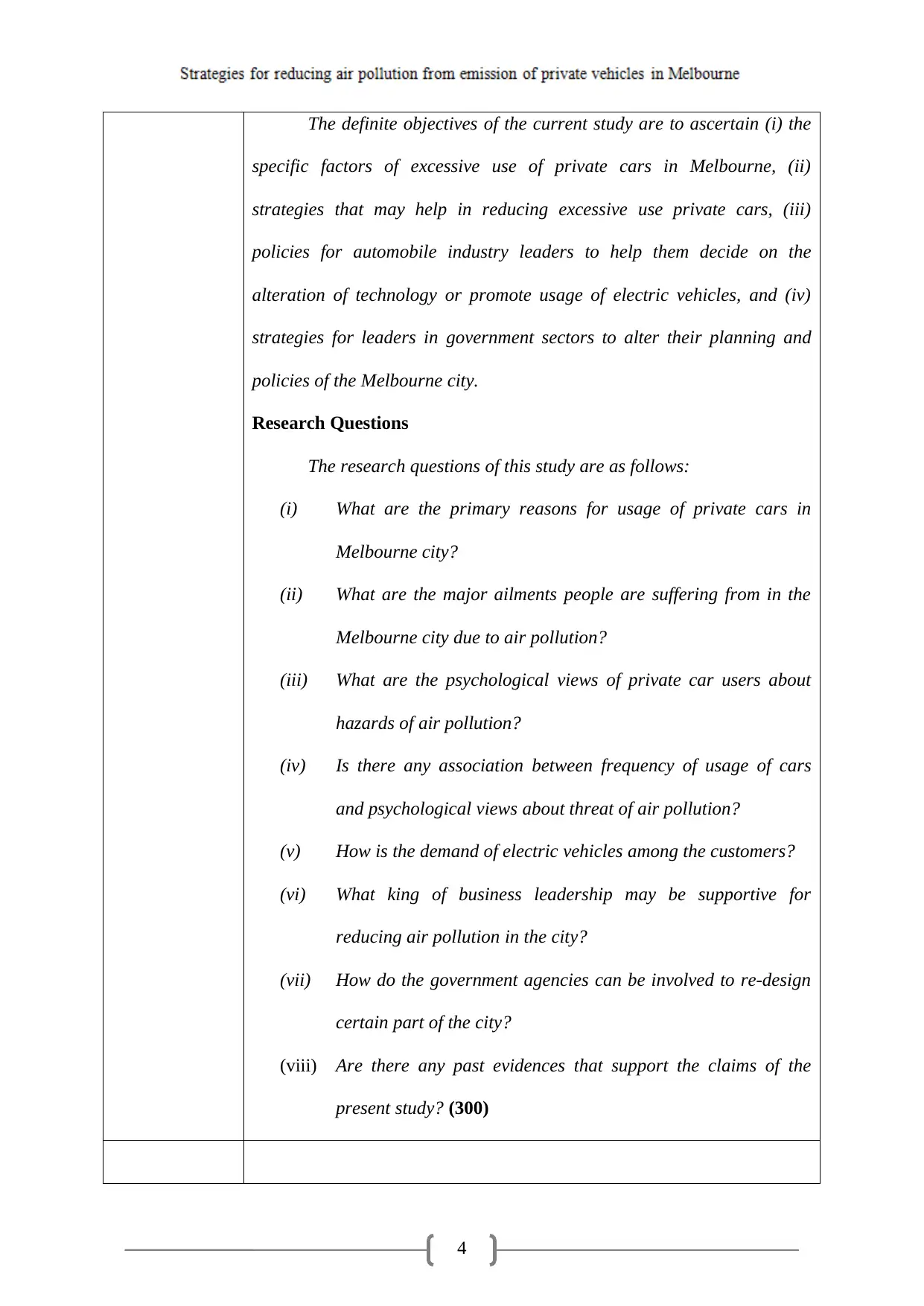
4
The definite objectives of the current study are to ascertain (i) the
specific factors of excessive use of private cars in Melbourne, (ii)
strategies that may help in reducing excessive use private cars, (iii)
policies for automobile industry leaders to help them decide on the
alteration of technology or promote usage of electric vehicles, and (iv)
strategies for leaders in government sectors to alter their planning and
policies of the Melbourne city.
Research Questions
The research questions of this study are as follows:
(i) What are the primary reasons for usage of private cars in
Melbourne city?
(ii) What are the major ailments people are suffering from in the
Melbourne city due to air pollution?
(iii) What are the psychological views of private car users about
hazards of air pollution?
(iv) Is there any association between frequency of usage of cars
and psychological views about threat of air pollution?
(v) How is the demand of electric vehicles among the customers?
(vi) What king of business leadership may be supportive for
reducing air pollution in the city?
(vii) How do the government agencies can be involved to re-design
certain part of the city?
(viii) Are there any past evidences that support the claims of the
present study? (300)
The definite objectives of the current study are to ascertain (i) the
specific factors of excessive use of private cars in Melbourne, (ii)
strategies that may help in reducing excessive use private cars, (iii)
policies for automobile industry leaders to help them decide on the
alteration of technology or promote usage of electric vehicles, and (iv)
strategies for leaders in government sectors to alter their planning and
policies of the Melbourne city.
Research Questions
The research questions of this study are as follows:
(i) What are the primary reasons for usage of private cars in
Melbourne city?
(ii) What are the major ailments people are suffering from in the
Melbourne city due to air pollution?
(iii) What are the psychological views of private car users about
hazards of air pollution?
(iv) Is there any association between frequency of usage of cars
and psychological views about threat of air pollution?
(v) How is the demand of electric vehicles among the customers?
(vi) What king of business leadership may be supportive for
reducing air pollution in the city?
(vii) How do the government agencies can be involved to re-design
certain part of the city?
(viii) Are there any past evidences that support the claims of the
present study? (300)
Secure Best Marks with AI Grader
Need help grading? Try our AI Grader for instant feedback on your assignments.

5
Literature
Review
References
Broadbent, G. H., Drozdzewski, D., & Metternicht, G. (2018). Electric
vehicle adoption: An analysis of best practice and pitfalls for
policy making from experiences of Europe and the US. Geography
Compass, 12(2), e12358.
Dia, H., & Javanshour, F. (2017). Autonomous shared mobility-on-
demand: Melbourne pilot simulation study. Transportation
Research Procedia, 22, 285-296.
Habib, S., Kamran, M., & Rashid, U. (2015). Impact analysis of vehicle-
to-grid technology and charging strategies of electric vehicles on
distribution networks–a review. Journal of Power Sources, 277,
205-214.
Igliński, H., & Babiak, M. (2017). Analysis of the potential of autonomous
vehicles in reducing the emissions of greenhouse gases in road
transport. Procedia engineering, 192, 353-358.
Jalali, R., Koohi-Fayegh, S., El-Khatib, K., Hoornweg, D., & Li, H.
(2017). Investigating the potential of ridesharing to reduce vehicle
emissions. Urban Planning, 2(2), 26-40.
Kelly, J. C., Sullivan, J. L., Burnham, A., & Elgowainy, A. (2015).
Impacts of vehicle weight reduction via material substitution on
life-cycle greenhouse gas emissions. Environmental science &
technology, 49(20), 12535-12542.
Kibria, G., Haroon, A. K., & Nugegoda, D. (2018). Low-Carbon
Development (LCD) Pathways in Australia, Bangladesh, China
and India—A Review. Journal of Climate Change, 4(1), 49-61.
Literature
Review
References
Broadbent, G. H., Drozdzewski, D., & Metternicht, G. (2018). Electric
vehicle adoption: An analysis of best practice and pitfalls for
policy making from experiences of Europe and the US. Geography
Compass, 12(2), e12358.
Dia, H., & Javanshour, F. (2017). Autonomous shared mobility-on-
demand: Melbourne pilot simulation study. Transportation
Research Procedia, 22, 285-296.
Habib, S., Kamran, M., & Rashid, U. (2015). Impact analysis of vehicle-
to-grid technology and charging strategies of electric vehicles on
distribution networks–a review. Journal of Power Sources, 277,
205-214.
Igliński, H., & Babiak, M. (2017). Analysis of the potential of autonomous
vehicles in reducing the emissions of greenhouse gases in road
transport. Procedia engineering, 192, 353-358.
Jalali, R., Koohi-Fayegh, S., El-Khatib, K., Hoornweg, D., & Li, H.
(2017). Investigating the potential of ridesharing to reduce vehicle
emissions. Urban Planning, 2(2), 26-40.
Kelly, J. C., Sullivan, J. L., Burnham, A., & Elgowainy, A. (2015).
Impacts of vehicle weight reduction via material substitution on
life-cycle greenhouse gas emissions. Environmental science &
technology, 49(20), 12535-12542.
Kibria, G., Haroon, A. K., & Nugegoda, D. (2018). Low-Carbon
Development (LCD) Pathways in Australia, Bangladesh, China
and India—A Review. Journal of Climate Change, 4(1), 49-61.
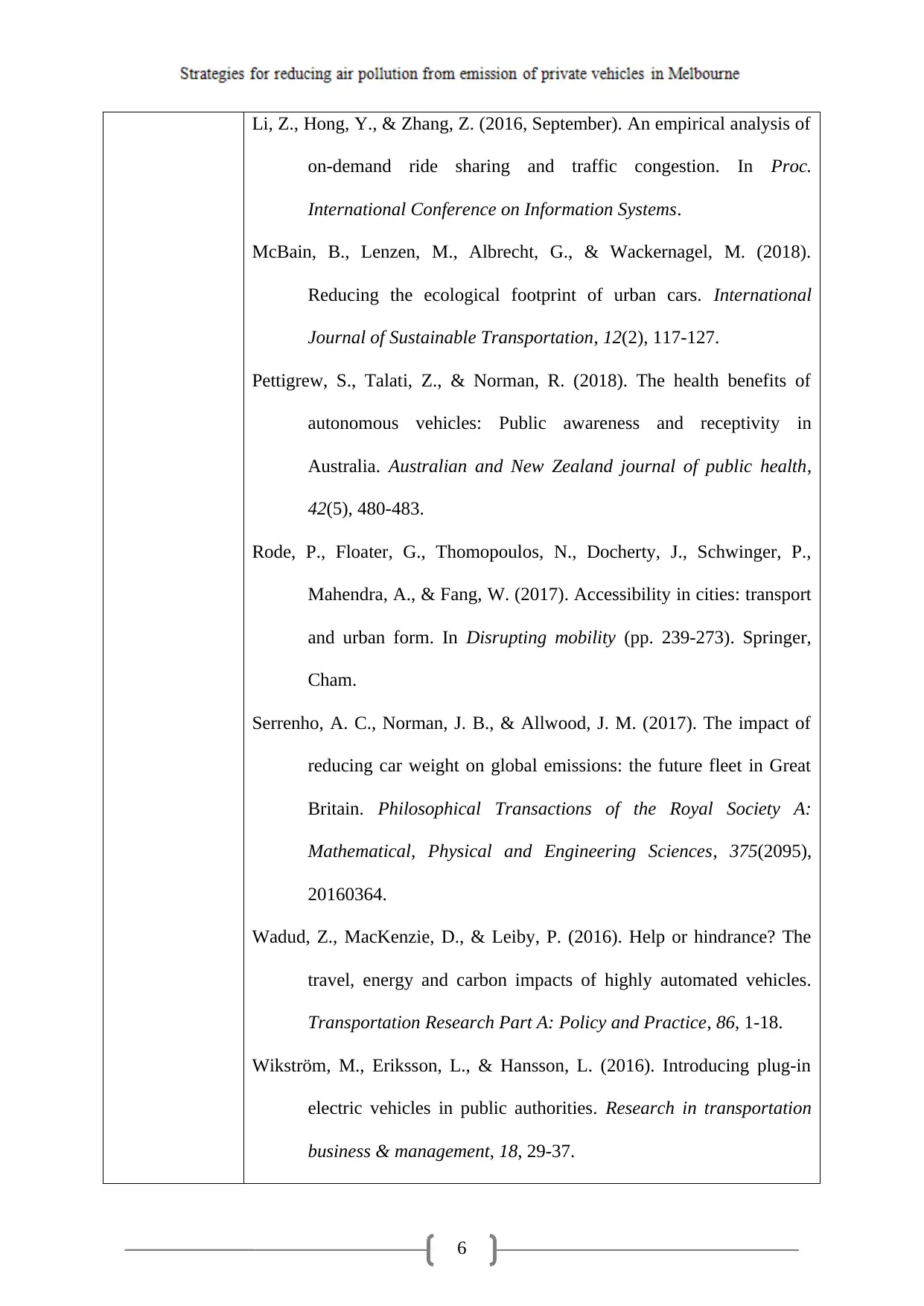
6
Li, Z., Hong, Y., & Zhang, Z. (2016, September). An empirical analysis of
on-demand ride sharing and traffic congestion. In Proc.
International Conference on Information Systems.
McBain, B., Lenzen, M., Albrecht, G., & Wackernagel, M. (2018).
Reducing the ecological footprint of urban cars. International
Journal of Sustainable Transportation, 12(2), 117-127.
Pettigrew, S., Talati, Z., & Norman, R. (2018). The health benefits of
autonomous vehicles: Public awareness and receptivity in
Australia. Australian and New Zealand journal of public health,
42(5), 480-483.
Rode, P., Floater, G., Thomopoulos, N., Docherty, J., Schwinger, P.,
Mahendra, A., & Fang, W. (2017). Accessibility in cities: transport
and urban form. In Disrupting mobility (pp. 239-273). Springer,
Cham.
Serrenho, A. C., Norman, J. B., & Allwood, J. M. (2017). The impact of
reducing car weight on global emissions: the future fleet in Great
Britain. Philosophical Transactions of the Royal Society A:
Mathematical, Physical and Engineering Sciences, 375(2095),
20160364.
Wadud, Z., MacKenzie, D., & Leiby, P. (2016). Help or hindrance? The
travel, energy and carbon impacts of highly automated vehicles.
Transportation Research Part A: Policy and Practice, 86, 1-18.
Wikström, M., Eriksson, L., & Hansson, L. (2016). Introducing plug-in
electric vehicles in public authorities. Research in transportation
business & management, 18, 29-37.
Li, Z., Hong, Y., & Zhang, Z. (2016, September). An empirical analysis of
on-demand ride sharing and traffic congestion. In Proc.
International Conference on Information Systems.
McBain, B., Lenzen, M., Albrecht, G., & Wackernagel, M. (2018).
Reducing the ecological footprint of urban cars. International
Journal of Sustainable Transportation, 12(2), 117-127.
Pettigrew, S., Talati, Z., & Norman, R. (2018). The health benefits of
autonomous vehicles: Public awareness and receptivity in
Australia. Australian and New Zealand journal of public health,
42(5), 480-483.
Rode, P., Floater, G., Thomopoulos, N., Docherty, J., Schwinger, P.,
Mahendra, A., & Fang, W. (2017). Accessibility in cities: transport
and urban form. In Disrupting mobility (pp. 239-273). Springer,
Cham.
Serrenho, A. C., Norman, J. B., & Allwood, J. M. (2017). The impact of
reducing car weight on global emissions: the future fleet in Great
Britain. Philosophical Transactions of the Royal Society A:
Mathematical, Physical and Engineering Sciences, 375(2095),
20160364.
Wadud, Z., MacKenzie, D., & Leiby, P. (2016). Help or hindrance? The
travel, energy and carbon impacts of highly automated vehicles.
Transportation Research Part A: Policy and Practice, 86, 1-18.
Wikström, M., Eriksson, L., & Hansson, L. (2016). Introducing plug-in
electric vehicles in public authorities. Research in transportation
business & management, 18, 29-37.
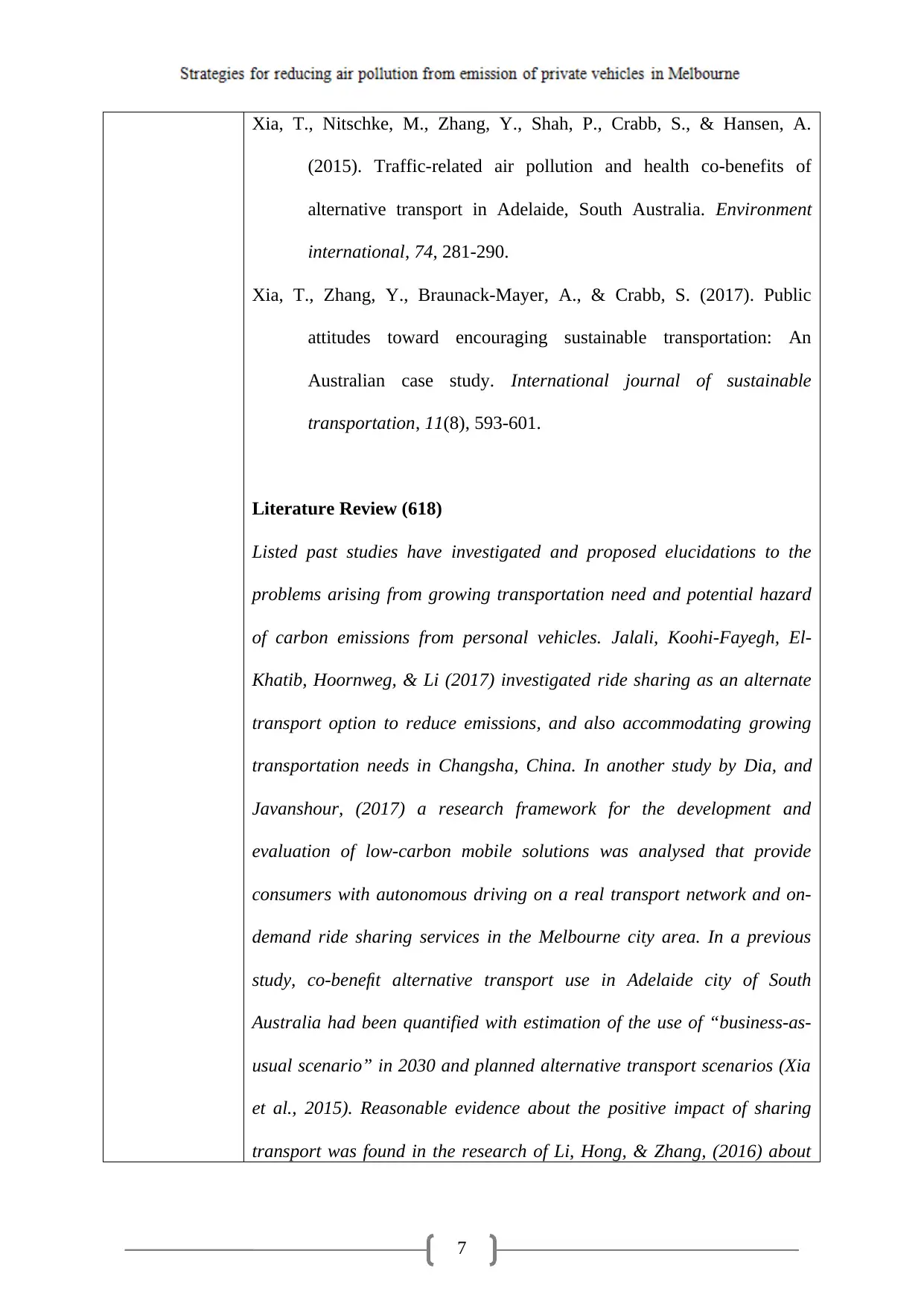
7
Xia, T., Nitschke, M., Zhang, Y., Shah, P., Crabb, S., & Hansen, A.
(2015). Traffic-related air pollution and health co-benefits of
alternative transport in Adelaide, South Australia. Environment
international, 74, 281-290.
Xia, T., Zhang, Y., Braunack-Mayer, A., & Crabb, S. (2017). Public
attitudes toward encouraging sustainable transportation: An
Australian case study. International journal of sustainable
transportation, 11(8), 593-601.
Literature Review (618)
Listed past studies have investigated and proposed elucidations to the
problems arising from growing transportation need and potential hazard
of carbon emissions from personal vehicles. Jalali, Koohi-Fayegh, El-
Khatib, Hoornweg, & Li (2017) investigated ride sharing as an alternate
transport option to reduce emissions, and also accommodating growing
transportation needs in Changsha, China. In another study by Dia, and
Javanshour, (2017) a research framework for the development and
evaluation of low-carbon mobile solutions was analysed that provide
consumers with autonomous driving on a real transport network and on-
demand ride sharing services in the Melbourne city area. In a previous
study, co-benefit alternative transport use in Adelaide city of South
Australia had been quantified with estimation of the use of “business-as-
usual scenario” in 2030 and planned alternative transport scenarios (Xia
et al., 2015). Reasonable evidence about the positive impact of sharing
transport was found in the research of Li, Hong, & Zhang, (2016) about
Xia, T., Nitschke, M., Zhang, Y., Shah, P., Crabb, S., & Hansen, A.
(2015). Traffic-related air pollution and health co-benefits of
alternative transport in Adelaide, South Australia. Environment
international, 74, 281-290.
Xia, T., Zhang, Y., Braunack-Mayer, A., & Crabb, S. (2017). Public
attitudes toward encouraging sustainable transportation: An
Australian case study. International journal of sustainable
transportation, 11(8), 593-601.
Literature Review (618)
Listed past studies have investigated and proposed elucidations to the
problems arising from growing transportation need and potential hazard
of carbon emissions from personal vehicles. Jalali, Koohi-Fayegh, El-
Khatib, Hoornweg, & Li (2017) investigated ride sharing as an alternate
transport option to reduce emissions, and also accommodating growing
transportation needs in Changsha, China. In another study by Dia, and
Javanshour, (2017) a research framework for the development and
evaluation of low-carbon mobile solutions was analysed that provide
consumers with autonomous driving on a real transport network and on-
demand ride sharing services in the Melbourne city area. In a previous
study, co-benefit alternative transport use in Adelaide city of South
Australia had been quantified with estimation of the use of “business-as-
usual scenario” in 2030 and planned alternative transport scenarios (Xia
et al., 2015). Reasonable evidence about the positive impact of sharing
transport was found in the research of Li, Hong, & Zhang, (2016) about
Paraphrase This Document
Need a fresh take? Get an instant paraphrase of this document with our AI Paraphraser
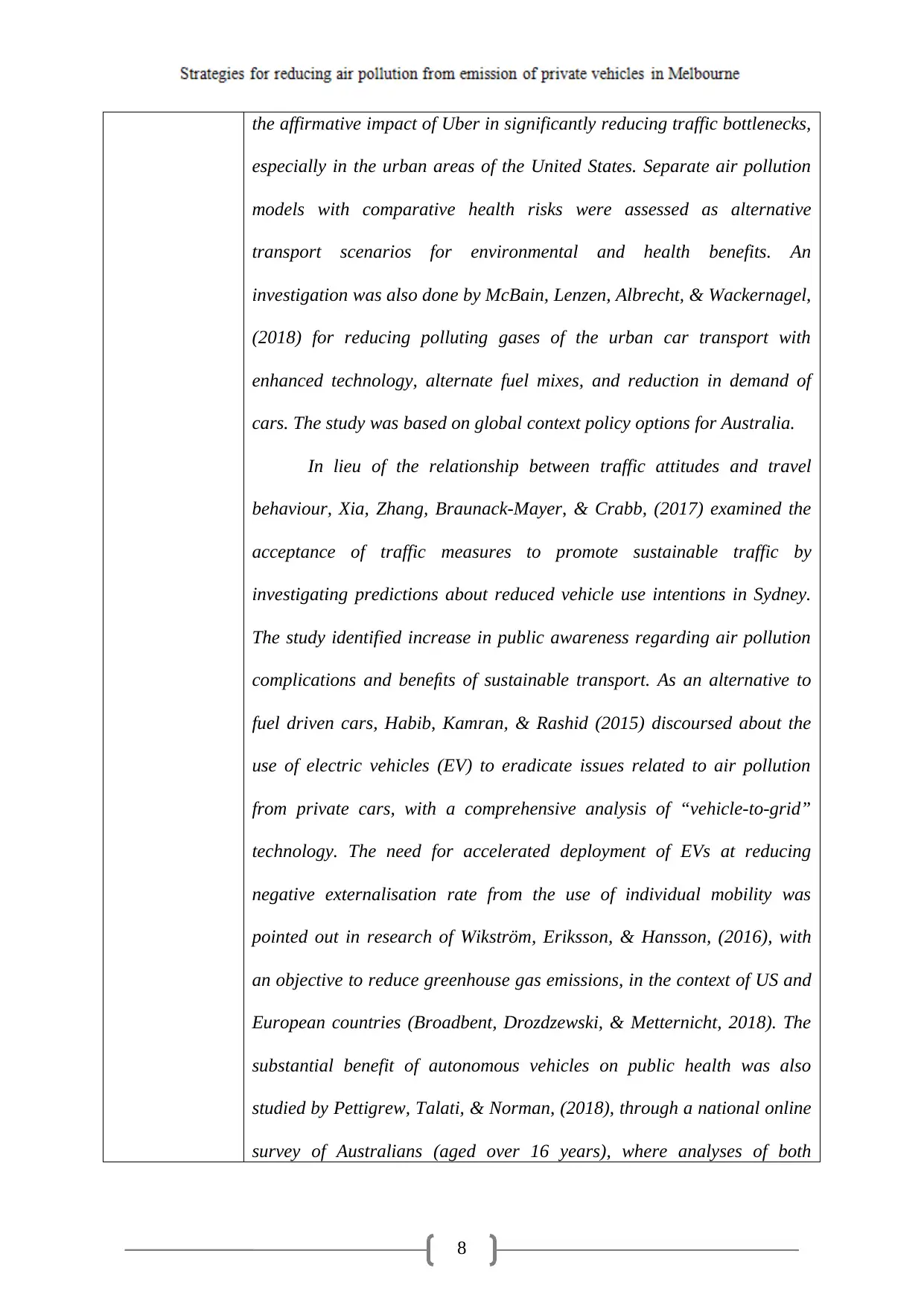
8
the affirmative impact of Uber in significantly reducing traffic bottlenecks,
especially in the urban areas of the United States. Separate air pollution
models with comparative health risks were assessed as alternative
transport scenarios for environmental and health benefits. An
investigation was also done by McBain, Lenzen, Albrecht, & Wackernagel,
(2018) for reducing polluting gases of the urban car transport with
enhanced technology, alternate fuel mixes, and reduction in demand of
cars. The study was based on global context policy options for Australia.
In lieu of the relationship between traffic attitudes and travel
behaviour, Xia, Zhang, Braunack-Mayer, & Crabb, (2017) examined the
acceptance of traffic measures to promote sustainable traffic by
investigating predictions about reduced vehicle use intentions in Sydney.
The study identified increase in public awareness regarding air pollution
complications and benefits of sustainable transport. As an alternative to
fuel driven cars, Habib, Kamran, & Rashid (2015) discoursed about the
use of electric vehicles (EV) to eradicate issues related to air pollution
from private cars, with a comprehensive analysis of “vehicle-to-grid”
technology. The need for accelerated deployment of EVs at reducing
negative externalisation rate from the use of individual mobility was
pointed out in research of Wikström, Eriksson, & Hansson, (2016), with
an objective to reduce greenhouse gas emissions, in the context of US and
European countries (Broadbent, Drozdzewski, & Metternicht, 2018). The
substantial benefit of autonomous vehicles on public health was also
studied by Pettigrew, Talati, & Norman, (2018), through a national online
survey of Australians (aged over 16 years), where analyses of both
the affirmative impact of Uber in significantly reducing traffic bottlenecks,
especially in the urban areas of the United States. Separate air pollution
models with comparative health risks were assessed as alternative
transport scenarios for environmental and health benefits. An
investigation was also done by McBain, Lenzen, Albrecht, & Wackernagel,
(2018) for reducing polluting gases of the urban car transport with
enhanced technology, alternate fuel mixes, and reduction in demand of
cars. The study was based on global context policy options for Australia.
In lieu of the relationship between traffic attitudes and travel
behaviour, Xia, Zhang, Braunack-Mayer, & Crabb, (2017) examined the
acceptance of traffic measures to promote sustainable traffic by
investigating predictions about reduced vehicle use intentions in Sydney.
The study identified increase in public awareness regarding air pollution
complications and benefits of sustainable transport. As an alternative to
fuel driven cars, Habib, Kamran, & Rashid (2015) discoursed about the
use of electric vehicles (EV) to eradicate issues related to air pollution
from private cars, with a comprehensive analysis of “vehicle-to-grid”
technology. The need for accelerated deployment of EVs at reducing
negative externalisation rate from the use of individual mobility was
pointed out in research of Wikström, Eriksson, & Hansson, (2016), with
an objective to reduce greenhouse gas emissions, in the context of US and
European countries (Broadbent, Drozdzewski, & Metternicht, 2018). The
substantial benefit of autonomous vehicles on public health was also
studied by Pettigrew, Talati, & Norman, (2018), through a national online
survey of Australians (aged over 16 years), where analyses of both
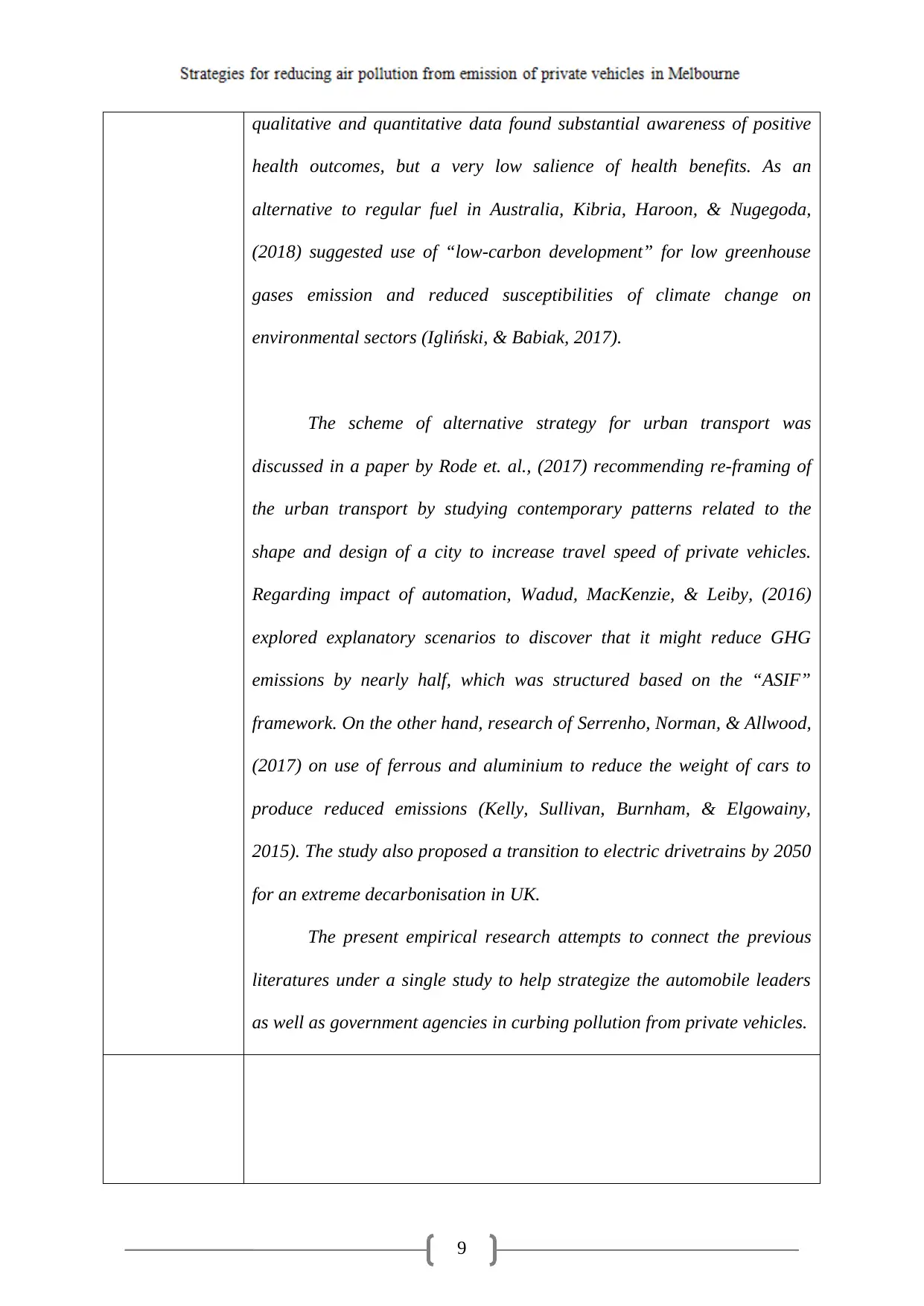
9
qualitative and quantitative data found substantial awareness of positive
health outcomes, but a very low salience of health benefits. As an
alternative to regular fuel in Australia, Kibria, Haroon, & Nugegoda,
(2018) suggested use of “low-carbon development” for low greenhouse
gases emission and reduced susceptibilities of climate change on
environmental sectors (Igliński, & Babiak, 2017).
The scheme of alternative strategy for urban transport was
discussed in a paper by Rode et. al., (2017) recommending re-framing of
the urban transport by studying contemporary patterns related to the
shape and design of a city to increase travel speed of private vehicles.
Regarding impact of automation, Wadud, MacKenzie, & Leiby, (2016)
explored explanatory scenarios to discover that it might reduce GHG
emissions by nearly half, which was structured based on the “ASIF”
framework. On the other hand, research of Serrenho, Norman, & Allwood,
(2017) on use of ferrous and aluminium to reduce the weight of cars to
produce reduced emissions (Kelly, Sullivan, Burnham, & Elgowainy,
2015). The study also proposed a transition to electric drivetrains by 2050
for an extreme decarbonisation in UK.
The present empirical research attempts to connect the previous
literatures under a single study to help strategize the automobile leaders
as well as government agencies in curbing pollution from private vehicles.
qualitative and quantitative data found substantial awareness of positive
health outcomes, but a very low salience of health benefits. As an
alternative to regular fuel in Australia, Kibria, Haroon, & Nugegoda,
(2018) suggested use of “low-carbon development” for low greenhouse
gases emission and reduced susceptibilities of climate change on
environmental sectors (Igliński, & Babiak, 2017).
The scheme of alternative strategy for urban transport was
discussed in a paper by Rode et. al., (2017) recommending re-framing of
the urban transport by studying contemporary patterns related to the
shape and design of a city to increase travel speed of private vehicles.
Regarding impact of automation, Wadud, MacKenzie, & Leiby, (2016)
explored explanatory scenarios to discover that it might reduce GHG
emissions by nearly half, which was structured based on the “ASIF”
framework. On the other hand, research of Serrenho, Norman, & Allwood,
(2017) on use of ferrous and aluminium to reduce the weight of cars to
produce reduced emissions (Kelly, Sullivan, Burnham, & Elgowainy,
2015). The study also proposed a transition to electric drivetrains by 2050
for an extreme decarbonisation in UK.
The present empirical research attempts to connect the previous
literatures under a single study to help strategize the automobile leaders
as well as government agencies in curbing pollution from private vehicles.
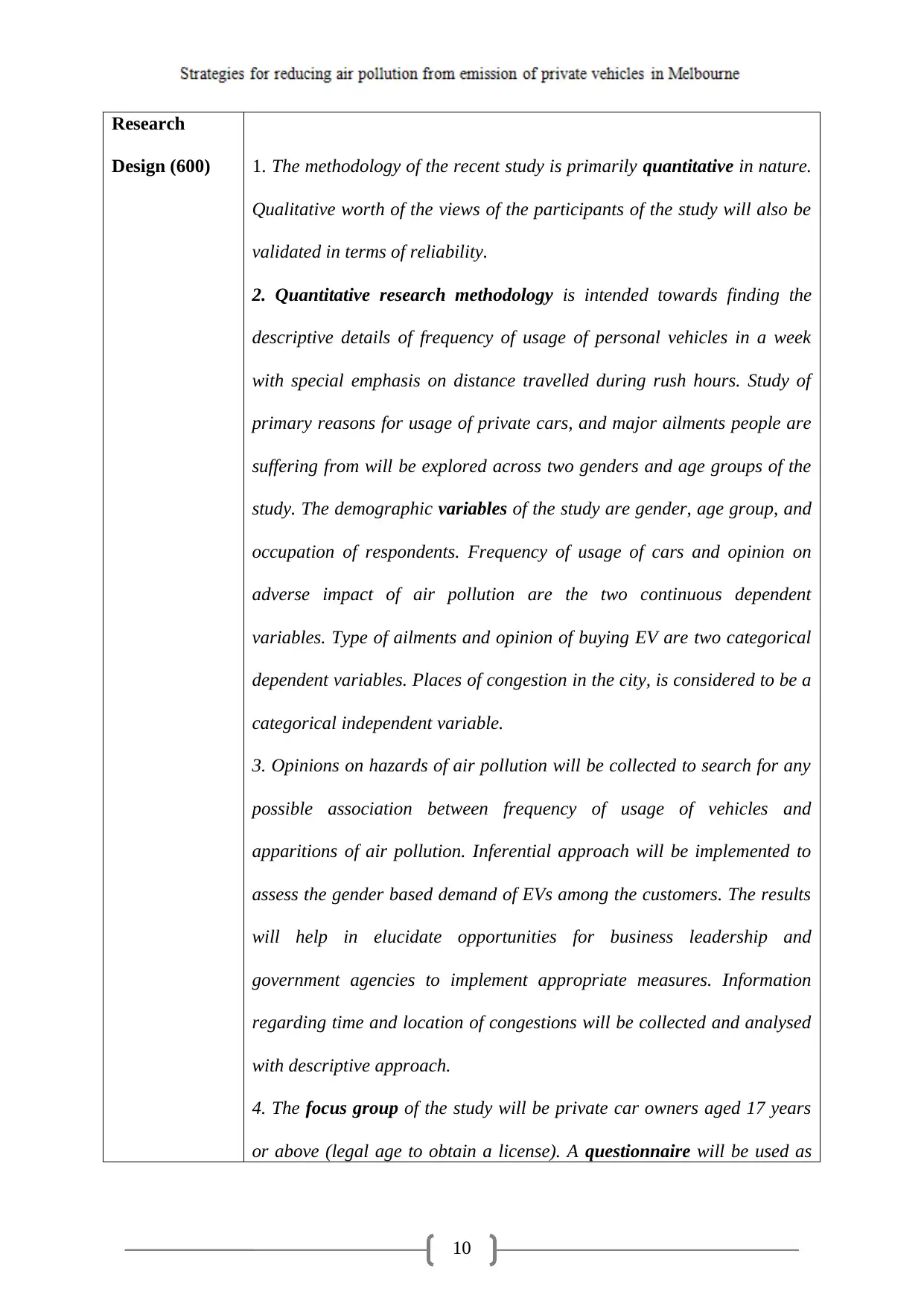
10
Research
Design (600) 1. The methodology of the recent study is primarily quantitative in nature.
Qualitative worth of the views of the participants of the study will also be
validated in terms of reliability.
2. Quantitative research methodology is intended towards finding the
descriptive details of frequency of usage of personal vehicles in a week
with special emphasis on distance travelled during rush hours. Study of
primary reasons for usage of private cars, and major ailments people are
suffering from will be explored across two genders and age groups of the
study. The demographic variables of the study are gender, age group, and
occupation of respondents. Frequency of usage of cars and opinion on
adverse impact of air pollution are the two continuous dependent
variables. Type of ailments and opinion of buying EV are two categorical
dependent variables. Places of congestion in the city, is considered to be a
categorical independent variable.
3. Opinions on hazards of air pollution will be collected to search for any
possible association between frequency of usage of vehicles and
apparitions of air pollution. Inferential approach will be implemented to
assess the gender based demand of EVs among the customers. The results
will help in elucidate opportunities for business leadership and
government agencies to implement appropriate measures. Information
regarding time and location of congestions will be collected and analysed
with descriptive approach.
4. The focus group of the study will be private car owners aged 17 years
or above (legal age to obtain a license). A questionnaire will be used as
Research
Design (600) 1. The methodology of the recent study is primarily quantitative in nature.
Qualitative worth of the views of the participants of the study will also be
validated in terms of reliability.
2. Quantitative research methodology is intended towards finding the
descriptive details of frequency of usage of personal vehicles in a week
with special emphasis on distance travelled during rush hours. Study of
primary reasons for usage of private cars, and major ailments people are
suffering from will be explored across two genders and age groups of the
study. The demographic variables of the study are gender, age group, and
occupation of respondents. Frequency of usage of cars and opinion on
adverse impact of air pollution are the two continuous dependent
variables. Type of ailments and opinion of buying EV are two categorical
dependent variables. Places of congestion in the city, is considered to be a
categorical independent variable.
3. Opinions on hazards of air pollution will be collected to search for any
possible association between frequency of usage of vehicles and
apparitions of air pollution. Inferential approach will be implemented to
assess the gender based demand of EVs among the customers. The results
will help in elucidate opportunities for business leadership and
government agencies to implement appropriate measures. Information
regarding time and location of congestions will be collected and analysed
with descriptive approach.
4. The focus group of the study will be private car owners aged 17 years
or above (legal age to obtain a license). A questionnaire will be used as
Secure Best Marks with AI Grader
Need help grading? Try our AI Grader for instant feedback on your assignments.
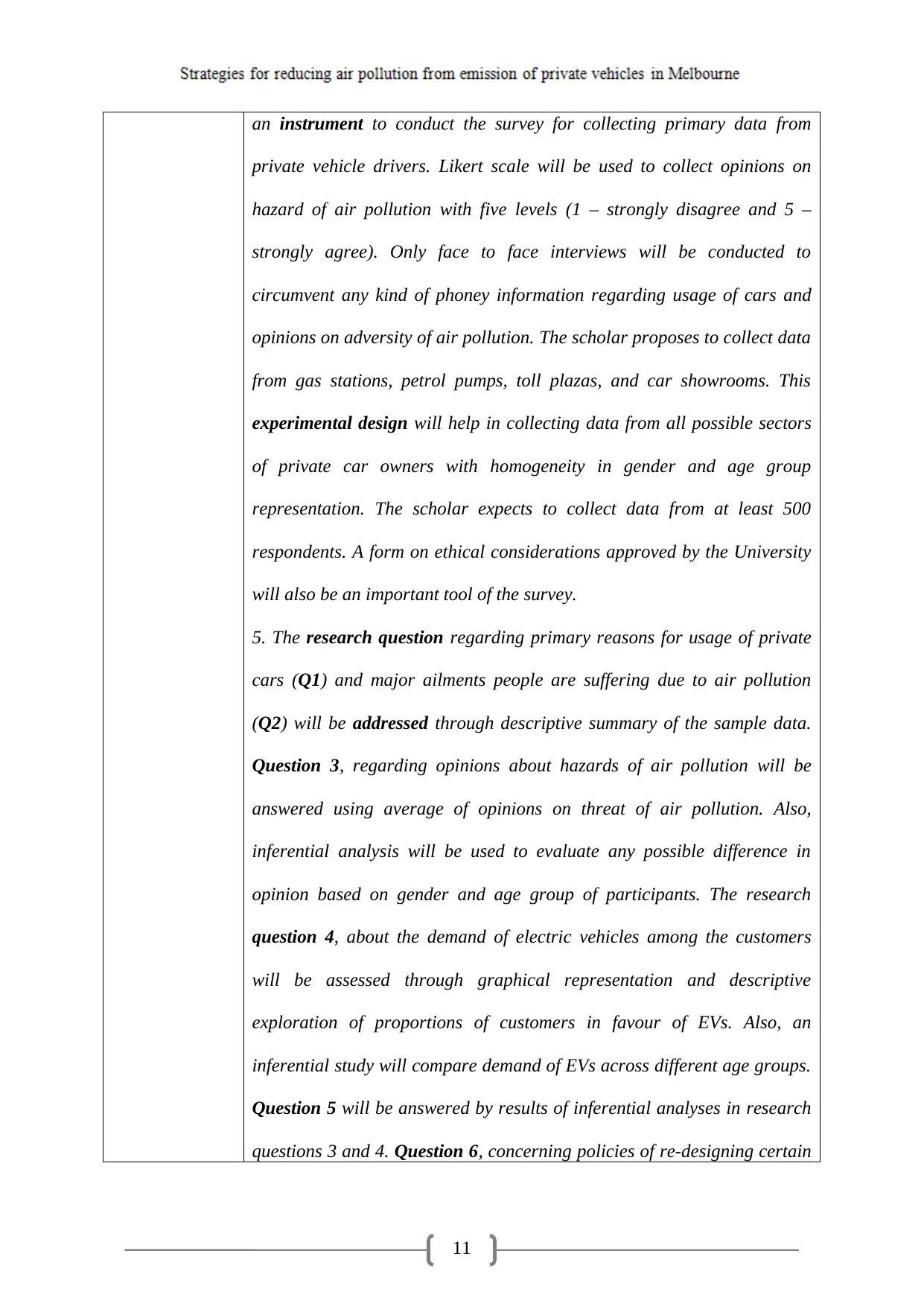
11
an instrument to conduct the survey for collecting primary data from
private vehicle drivers. Likert scale will be used to collect opinions on
hazard of air pollution with five levels (1 – strongly disagree and 5 –
strongly agree). Only face to face interviews will be conducted to
circumvent any kind of phoney information regarding usage of cars and
opinions on adversity of air pollution. The scholar proposes to collect data
from gas stations, petrol pumps, toll plazas, and car showrooms. This
experimental design will help in collecting data from all possible sectors
of private car owners with homogeneity in gender and age group
representation. The scholar expects to collect data from at least 500
respondents. A form on ethical considerations approved by the University
will also be an important tool of the survey.
5. The research question regarding primary reasons for usage of private
cars (Q1) and major ailments people are suffering due to air pollution
(Q2) will be addressed through descriptive summary of the sample data.
Question 3, regarding opinions about hazards of air pollution will be
answered using average of opinions on threat of air pollution. Also,
inferential analysis will be used to evaluate any possible difference in
opinion based on gender and age group of participants. The research
question 4, about the demand of electric vehicles among the customers
will be assessed through graphical representation and descriptive
exploration of proportions of customers in favour of EVs. Also, an
inferential study will compare demand of EVs across different age groups.
Question 5 will be answered by results of inferential analyses in research
questions 3 and 4. Question 6, concerning policies of re-designing certain
an instrument to conduct the survey for collecting primary data from
private vehicle drivers. Likert scale will be used to collect opinions on
hazard of air pollution with five levels (1 – strongly disagree and 5 –
strongly agree). Only face to face interviews will be conducted to
circumvent any kind of phoney information regarding usage of cars and
opinions on adversity of air pollution. The scholar proposes to collect data
from gas stations, petrol pumps, toll plazas, and car showrooms. This
experimental design will help in collecting data from all possible sectors
of private car owners with homogeneity in gender and age group
representation. The scholar expects to collect data from at least 500
respondents. A form on ethical considerations approved by the University
will also be an important tool of the survey.
5. The research question regarding primary reasons for usage of private
cars (Q1) and major ailments people are suffering due to air pollution
(Q2) will be addressed through descriptive summary of the sample data.
Question 3, regarding opinions about hazards of air pollution will be
answered using average of opinions on threat of air pollution. Also,
inferential analysis will be used to evaluate any possible difference in
opinion based on gender and age group of participants. The research
question 4, about the demand of electric vehicles among the customers
will be assessed through graphical representation and descriptive
exploration of proportions of customers in favour of EVs. Also, an
inferential study will compare demand of EVs across different age groups.
Question 5 will be answered by results of inferential analyses in research
questions 3 and 4. Question 6, concerning policies of re-designing certain
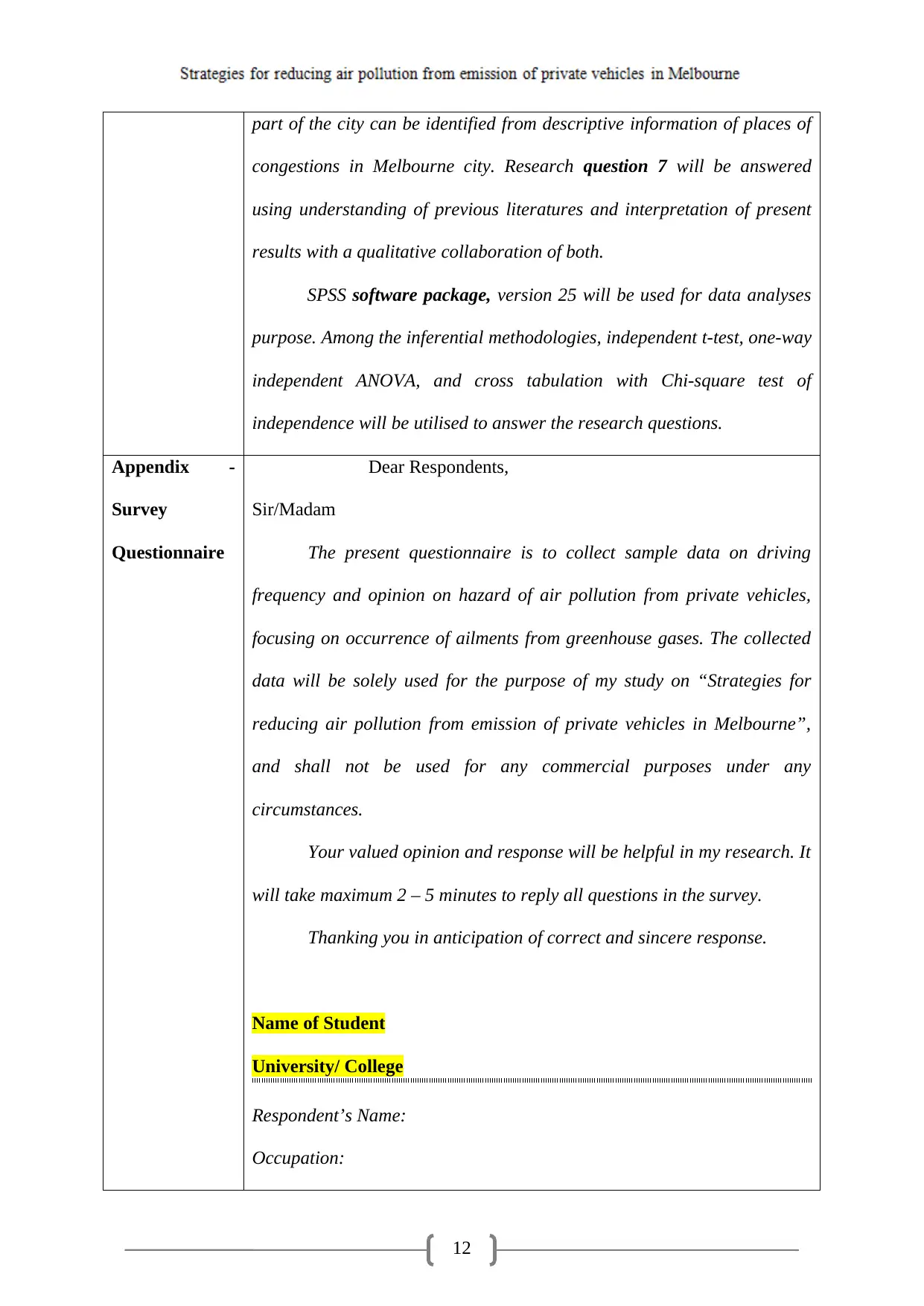
12
part of the city can be identified from descriptive information of places of
congestions in Melbourne city. Research question 7 will be answered
using understanding of previous literatures and interpretation of present
results with a qualitative collaboration of both.
SPSS software package, version 25 will be used for data analyses
purpose. Among the inferential methodologies, independent t-test, one-way
independent ANOVA, and cross tabulation with Chi-square test of
independence will be utilised to answer the research questions.
Appendix -
Survey
Questionnaire
Dear Respondents,
Sir/Madam
The present questionnaire is to collect sample data on driving
frequency and opinion on hazard of air pollution from private vehicles,
focusing on occurrence of ailments from greenhouse gases. The collected
data will be solely used for the purpose of my study on “Strategies for
reducing air pollution from emission of private vehicles in Melbourne”,
and shall not be used for any commercial purposes under any
circumstances.
Your valued opinion and response will be helpful in my research. It
will take maximum 2 – 5 minutes to reply all questions in the survey.
Thanking you in anticipation of correct and sincere response.
Name of Student
University/ College
Respondent’s Name:
Occupation:
part of the city can be identified from descriptive information of places of
congestions in Melbourne city. Research question 7 will be answered
using understanding of previous literatures and interpretation of present
results with a qualitative collaboration of both.
SPSS software package, version 25 will be used for data analyses
purpose. Among the inferential methodologies, independent t-test, one-way
independent ANOVA, and cross tabulation with Chi-square test of
independence will be utilised to answer the research questions.
Appendix -
Survey
Questionnaire
Dear Respondents,
Sir/Madam
The present questionnaire is to collect sample data on driving
frequency and opinion on hazard of air pollution from private vehicles,
focusing on occurrence of ailments from greenhouse gases. The collected
data will be solely used for the purpose of my study on “Strategies for
reducing air pollution from emission of private vehicles in Melbourne”,
and shall not be used for any commercial purposes under any
circumstances.
Your valued opinion and response will be helpful in my research. It
will take maximum 2 – 5 minutes to reply all questions in the survey.
Thanking you in anticipation of correct and sincere response.
Name of Student
University/ College
Respondent’s Name:
Occupation:

13
Age:
Gender: Male / Female (Please tick the correct option)
Type of vehicle:
Contact Number:
Nationality: _______________________________
Number of times you take your car in a day: ________________________
Approximate total hours spend driving in Melbourne in a day:
______________________
How many years you are driving your present vehicle:
___________________
Are you suffering from air borne diseases: Yes / No (Please tick the
correct choice)
If yes, then please specify the name of the ailment:
______________________
For how many years are you suffering from this / these ailments?:
___________________
Do you think air pollution from private vehicles is a menace? Yes / No
(Please tick the correct option)
If, yes, then please share your opinion on how strongly you feel air
pollution has an adverse impact on people.
(i) Strongly Disagree
(ii) Disagree
(iii) Neutral
(iv) Agree
(v) Strongly Agree
Age:
Gender: Male / Female (Please tick the correct option)
Type of vehicle:
Contact Number:
Nationality: _______________________________
Number of times you take your car in a day: ________________________
Approximate total hours spend driving in Melbourne in a day:
______________________
How many years you are driving your present vehicle:
___________________
Are you suffering from air borne diseases: Yes / No (Please tick the
correct choice)
If yes, then please specify the name of the ailment:
______________________
For how many years are you suffering from this / these ailments?:
___________________
Do you think air pollution from private vehicles is a menace? Yes / No
(Please tick the correct option)
If, yes, then please share your opinion on how strongly you feel air
pollution has an adverse impact on people.
(i) Strongly Disagree
(ii) Disagree
(iii) Neutral
(iv) Agree
(v) Strongly Agree
Paraphrase This Document
Need a fresh take? Get an instant paraphrase of this document with our AI Paraphraser
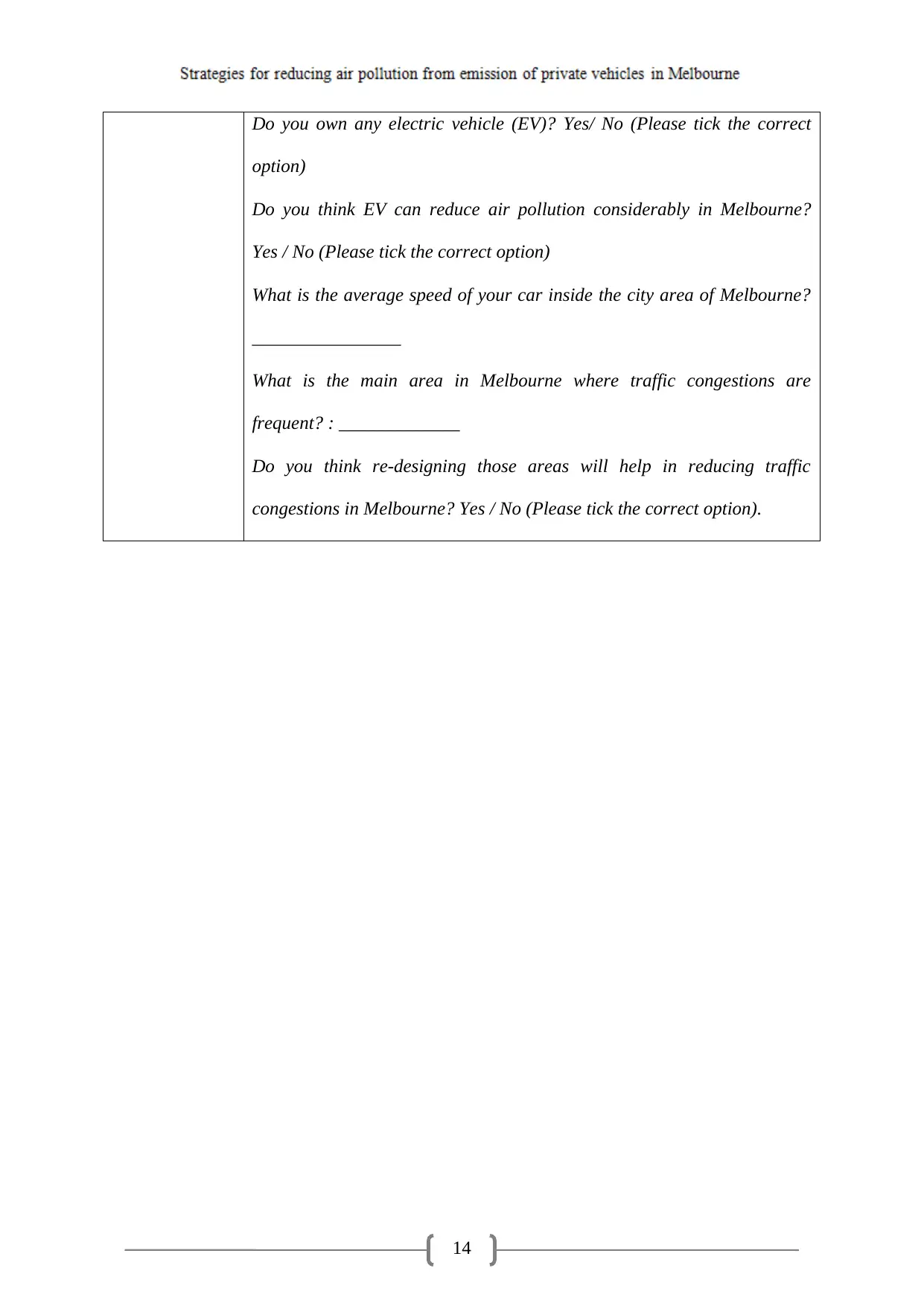
14
Do you own any electric vehicle (EV)? Yes/ No (Please tick the correct
option)
Do you think EV can reduce air pollution considerably in Melbourne?
Yes / No (Please tick the correct option)
What is the average speed of your car inside the city area of Melbourne?
________________
What is the main area in Melbourne where traffic congestions are
frequent? : _____________
Do you think re-designing those areas will help in reducing traffic
congestions in Melbourne? Yes / No (Please tick the correct option).
Do you own any electric vehicle (EV)? Yes/ No (Please tick the correct
option)
Do you think EV can reduce air pollution considerably in Melbourne?
Yes / No (Please tick the correct option)
What is the average speed of your car inside the city area of Melbourne?
________________
What is the main area in Melbourne where traffic congestions are
frequent? : _____________
Do you think re-designing those areas will help in reducing traffic
congestions in Melbourne? Yes / No (Please tick the correct option).
1 out of 14
Related Documents
Your All-in-One AI-Powered Toolkit for Academic Success.
+13062052269
info@desklib.com
Available 24*7 on WhatsApp / Email
![[object Object]](/_next/static/media/star-bottom.7253800d.svg)
Unlock your academic potential
© 2024 | Zucol Services PVT LTD | All rights reserved.





